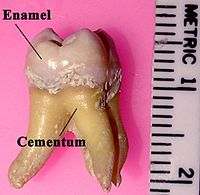
Photo from wikipedia
Hard dental tissues possess a complex hierarchical structure that is particularly evident in enamel, the most mineralised substance in the human body. Its complex and interlinked organisation at the Ångstrom… Click to show full abstract
Hard dental tissues possess a complex hierarchical structure that is particularly evident in enamel, the most mineralised substance in the human body. Its complex and interlinked organisation at the Ångstrom (crystal lattice), nano-, micro-, and macro-scales is the result of evolutionary optimisation for mechanical and functional performance: hardness and stiffness, fracture toughness, thermal, and chemical resistance. Understanding the physical–chemical–structural relationships at each scale requires the application of appropriately sensitive and resolving probes. Synchrotron X-ray techniques offer the possibility to progress significantly beyond the capabilities of conventional laboratory instruments, i.e., X-ray diffractometers, and electron and atomic force microscopes. The last few decades have witnessed the accumulation of results obtained from X-ray scattering (diffraction), spectroscopy (including polarisation analysis), and imaging (including ptychography and tomography). The current article presents a multi-disciplinary review of nearly 40 years of discoveries and advancements, primarily pertaining to the study of enamel and its demineralisation (caries), but also linked to the investigations of other mineralised tissues such as dentine, bone, etc. The modelling approaches informed by these observations are also overviewed. The strategic aim of the present review was to identify and evaluate prospective avenues for analysing dental tissues and developing treatments and prophylaxis for improved dental health.
Journal Title: Dentistry Journal
Year Published: 2023
Link to full text (if available)
Share on Social Media: Sign Up to like & get
recommendations!